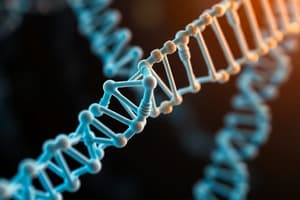Podcast
Questions and Answers
What does DNA stand for?
What does DNA stand for?
Deoxyribonucleic acid
Which of the following nitrogenous bases are found in DNA?
Which of the following nitrogenous bases are found in DNA?
- Guanine (G) (correct)
- Thymine (T) (correct)
- Uracil (U)
- Adenine (A) (correct)
DNA is a single-stranded molecule.
DNA is a single-stranded molecule.
False (B)
What bonds hold the nitrogenous bases together in DNA?
What bonds hold the nitrogenous bases together in DNA?
Which form of DNA is the most stable?
Which form of DNA is the most stable?
What is the distance between each turn of the B-DNA helix?
What is the distance between each turn of the B-DNA helix?
The molecules A-DNA and B-DNA are forms of ______.
The molecules A-DNA and B-DNA are forms of ______.
The major groove of DNA is narrower than the minor groove.
The major groove of DNA is narrower than the minor groove.
How many nitrogenous bases are complementary base pairs in DNA?
How many nitrogenous bases are complementary base pairs in DNA?
What is the width of the B-DNA helix?
What is the width of the B-DNA helix?
What is the structure type of Z-DNA?
What is the structure type of Z-DNA?
Flashcards are hidden until you start studying
Study Notes
DNA Structure and Function
- Deoxyribonucleic acid (DNA) serves as hereditary material in humans and all living organisms.
- DNA is a double-stranded molecule featuring a twisted helical structure.
- Composed of nucleotides, each nucleotide consists of a sugar (Deoxyribose), a phosphate group, and a nitrogenous base.
- Nitrogenous bases include Adenine (A), Guanine (G), Cytosine (C), and Thymine (T). A pairs with T and G pairs with C.
- Each base pair is joined by hydrogen bonds: A-T with 2 bonds, C-G with 3 bonds.
- DNA strands run anti-parallel: one from 5’ to 3’, the other from 3’ to 5’.
- Right-handed helices (B-form) is the most stable structure; left-handed helices (Z-DNA) exist but are less common.
- Melting temperature varies with base composition – regions high in C-G pairs (3 bonds) require more energy to separate than A-T regions (2 bonds).
- DNA measures 1.9 nm in diameter with each helical turn containing approximately 10 base pairs.
Grooves in DNA
- DNA forms major and minor grooves due to its double helical nature.
- Major groove: larger and occurs when backbones are farther apart, contains base pair-specific information.
- Minor groove: smaller, occurs when backbones are closer, often base pair nonspecific.
- Major groove measures 2.2 nm wide; minor groove measures 1.1 nm wide.
Types of DNA
-
A-DNA: Characterized by C3 endo conformation of deoxyribose.
- Base pairs are deviated towards the major groove.
- Contains 11 base pairs per turn, measuring 2.8 nm in length with a distance of 0.29 nm between base pairs.
- Appears narrower (2.3 nm width) but deeper major groove and shallower minor groove, often favored under low hydration conditions.
-
B-DNA: The most commonly recognized structure, described by Watson and Crick.
- Right-handed double helix with 10 base pairs per turn, measuring 3.4 nm in length and 0.34 nm between base pairs.
- Diameter of 1.9 nm with a major groove of 2.2 nm, allowing protein interactions, and a minor groove of 1.1 nm.
-
Z-DNA: A left-handed helix showing a different structural profile compared to A and B forms.
- Forms in sequences of alternating purines and pyrimidines, primarily under certain physiological conditions.
Studying That Suits You
Use AI to generate personalized quizzes and flashcards to suit your learning preferences.




